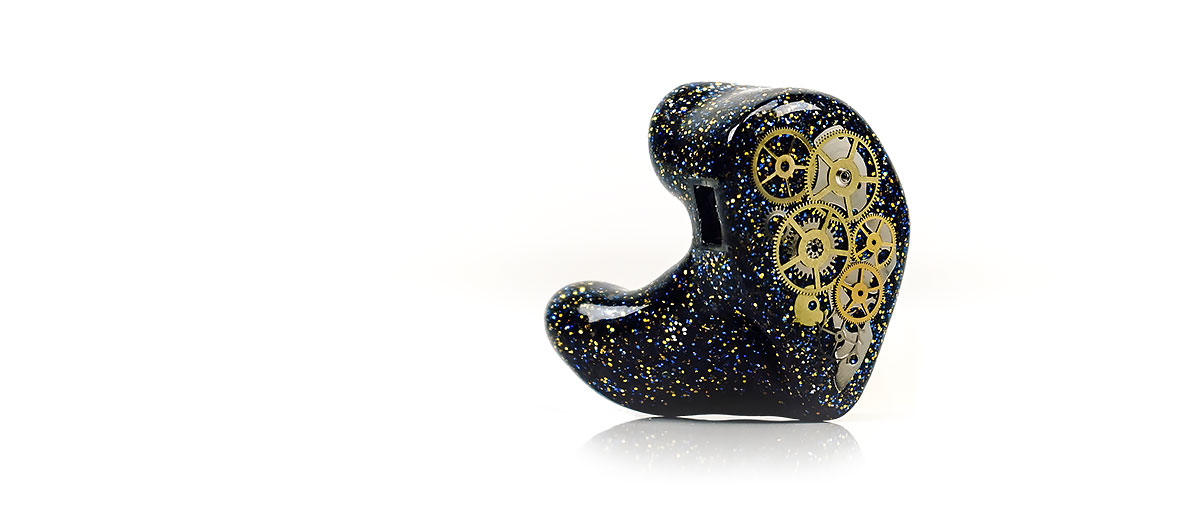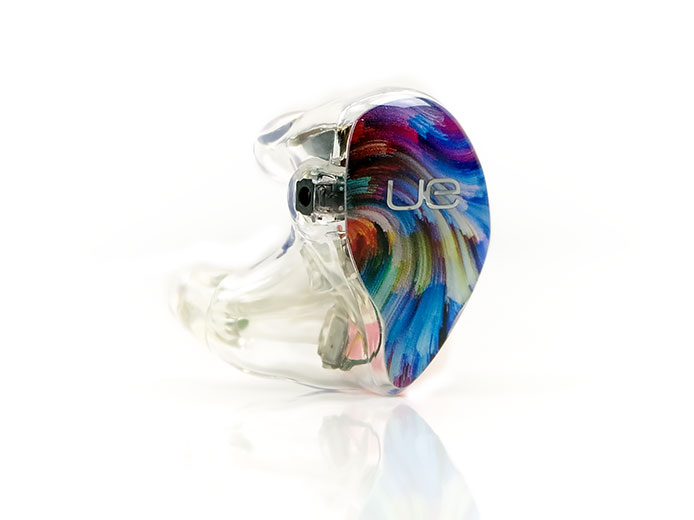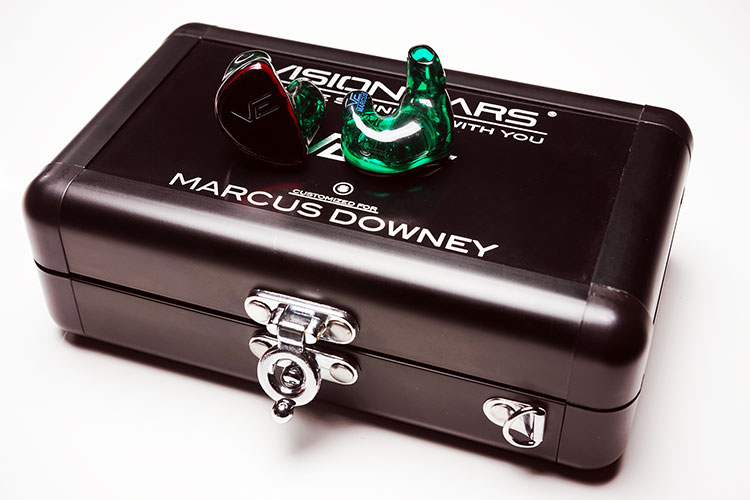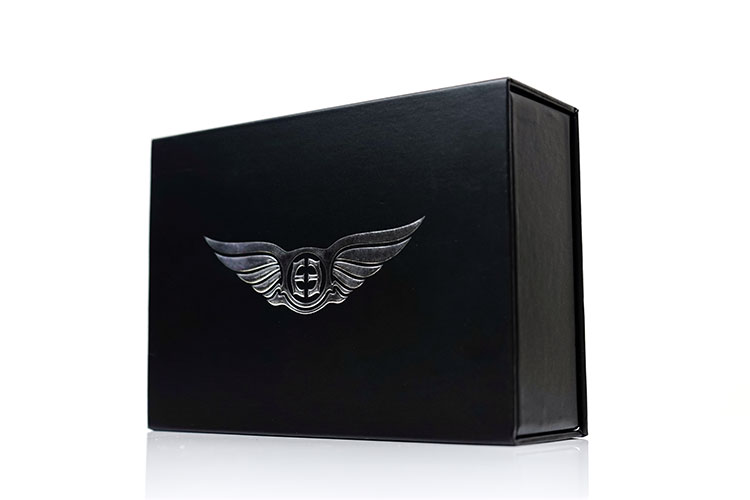Synergy
Efficiency
The Phantom is rated at just 10Ω and 117dB sensitivity. This is one heck of an easy monitor to drive out of any moderate source or good quality DAP. I am not entirely sure why you would resort to additional amping with the Phantom unless it is to acquire a measure of tonal shaping or additional dynamic range.
I put this easily in the same efficiency category as the Campfire Audio Andromeda and some VE models such as the VE8 for high sensitivity and low driving loads. Even out of a humble smartphone, albeit with better than average sound quality such as the LG G6, the Phantom sounds fulsome and highly engaging.
Avoid
Volume or gain is not an issue here unless the amp section is too powerful. There are a number of external amps that simply push it too hard such as the budget FiiO A5 or the RHA L1. Higher noise floor amps such as the Oriolus B300s and ALO Audio V5 are a no-go due to the Phantom picking up a lot of background hiss.
Embrace
If you wish to go OTG or line-out into an external amp then quieter better-suited amps including the FiiO Q5 and iFi’s Nano iDSD Black Label using the IEMatch output.
Interestingly, the low-z skew from the 10Ω output impedance of the HiBy R6 was not quite as big as I expected using the Phantom. Perhaps a slight reduction in the low-end but not as much as Andromeda’s thin bass and peaky highs response.
Synergy
The real key to unlocking the Phantom is the timbre of your source and the cable you are using. I highly recommend a neutral detailed source if you stick with the Ares II cable.
DAPs such as the iBasso DX200 and the AK240 gelled very nicely with the Phantom’s fleshier organic tones. Cayin’s N8 solid-state option was just magical but the tube option tended to soften the sound a little too much.
Cable Rolling
As good an entry-level 4-wire as the Ares II is the pairing with the Phantom delivers a performance that I would classify as too soft and too smooth for summit-fi.
Bumping it out for the Ares II 8-wire is a worthy upgrade for the Phantom with particular reference to treble clarity, superior dynamic range, and a more open soundstage. You can get even more satisfying results with the Effect Audio Leonidas II and their Janus Dynamic.
Leonidas II
The Leonidas II takes a little weight off the low-end compared to the Janus and places a little more emphasis on instrumental clarity and high-end articulation. While doing all this the Leonidas II still retains that very smooth Phantom sound which I think is an ultra-important factor for any Phantom owner.
Janus Dynamic
Pairing the Janus Dynamic 8-wire to the Phantom you will get a big jump in dynamic range and a far more vivid and involving soundstage. That superior dynamic range means micro-detail will be a lot more noticeable on the Phantom. You also get a much more open-sounding midrange with convincing instrumental separation and plenty of room for vocals to breathe.
Beyond that, the Phantom’s treble extension and sparkle are clearer and airier than the stock Ares II’s more muted performance. The harmonic balance is also better on the Janus because of the superior treble presence and slightly sweeter tone overall. From string plucks to percussion passages you just get a sound with this pairing that is more refined than the stock alternative.
Select Comparisons
Ultimate Ears 18+ Pro
$1,499.00
Purposing
The 18+ Pro is a 6 balanced armature custom monitor with 4 passive crossovers. It is rated at 37.5 Ohms @ 1kHz and 106dB sensitivity.
The tuning is purposed primarily for stage artists though there is some leeway for mixers also. The Phantom is viewed more as a reference tool for in-house monitoring though, to be honest, its unique tuning is decidedly less than neutral much like the 18+ Pro.
Build
The 18+ Pro is built using a 3D printing process rather than hand-made like the Phantom. Their design options are thus more limited but I like the accuracy of the build’s fit. I do rate the 18+ Pro as marginally more comfortable in the ear than my Phantom build.
However, the Phantom has a better seal with more background noise attenuation. Perhaps due to the additional levels of pressure, it exerts inside the ear or simply due to a different mold.
Cables
Both have excellent cables out of the box with the UE18+ using the super light and thin Super Bax from Linum and the Phantom using the EA Ares II.
The Super Bax is a quad-twisted 168 strand SPC wire with low noise and good handling. I tip my hat to how light the Super Bax is compared to the EA’s Ares II UPOCC 26AWG copper wire. The only problem is the IPX connectors used by UE for the 18+ Pro meaning it is difficult to roll and upgrade to a better wire if so inclined.
Performance
The numbers do not lie with the Phantom being an easier monitor to drive than the UE18+ Pro. Not by a huge margin but enough to make a difference in their presentations at similar volume levels on DAPs such as the iBasso DX200 and higher up with the Sony 1Z which had a 10-15 step gap in low gain.
Both will be fine from a decent DAP but those with higher noise floors such as the FiiO X3iii and Cayin N8 will yield a bit more noise and hiss on the Phantom than the 18+ Pro.
Tonality
The 18+ Pro is more neutral, more linear sounding but also not as expansive in its staging compared to the Phantom. The low-end is quite flat actually with barely a bump anywhere up to 800Hz-1k.
In fact, it dips a little which drops a bit of the lower midrange instrument presence and pulls the stage a little further away. The Phantom retains a much fuller low-end with enhanced body and lower mids instrumental presence.
The instrumental timbre on the 18+ Pro is not an overly lean sound. In fact, I found it fairly natural with a slight thickness to it though lacking in the same weight and fundamental overtone as the Phantoms more forward and aggressive sounding lower midrange. If you prefer a less invasive low-end then the 18+ Pro will give you that kind of balance.
Vocals
Both have a fairly controlled vocal presence with neither showing much elevation around the 1-2k range. My big concern with the 18+ Pro is a huge dip around 4-5k which affects upper mids and treble robbing it of space and air. It tends to mute a lot of percussions and some vocal clarity. Now the Phantom vocals are not exactly forward but they also have less of a dip around 4k.
The Phantom’s smaller dip means there is a bit more clarity and openness in its upper mids presentation. Combined with a livelier and somewhat airier sounding treble performance it just sounds the more spacious and livelier of the two.
Vision Ears VE5
€1430
Purposing
The VE5 is also a 5-BA driver custom monitor with a very unique purpose to emphasize vocal presence above all else. For me, as a vocalist lover, it is a dream CIEM to use but for others, it might be a bit too specialized in its imaging and instrumental placement. The Phantom takes a broader approach but does have a bit more low-end and lower midrange emphasis.
Build
The build on both are excellent and both isolate very well, possibly on par with each other. Vision Ears always make very comfortable monitors and the VE5 is no exception. It is slightly smaller than the Phantom with a narrower bend on the nozzle curve so it has a bit less ear canal pressure. Both also use a single horn nozzle design with a deep-set multi-bore tube delivery system.
Cables
Vision Ears stock cable is a throwaway Plastic One stock cable. It is 4-wire OFC, nice and light and low noise but has no dynamic range and sounds very veiled compared to the Phantom’s stock Ares II.
You can, however, upgrade to the excellent EA Thor copper cable for an additional 150 euros when checking out which puts the VE5 in the same price range as the Phantom. I would recommend you grab it to really open up the performance of the VE5.
Performance
Both monitors are easy to drive and quite sensitive with the VE5 at 21Ω and 122db and the Phantom at 10Ω and 117dB. Neither really need any external amping and will work with smartphones and low impedance DAPs very well.
Watch out for amps with high noise floors as both will show up background noise and hiss quite easily on the likes of the FiiO X3iii and at times the Cayin N8 on the summit-fi level. I tend to enjoy both out of my old AK380 for both a black background and volume control.
Tonality
If you could turn the FR of the Phantom upside down then you would almost have the VE5 presentation. It is almost the complete opposite apart from a similar nudge around 8k (upper treble).
The VE5 is much more n-shaped and focused on delivering a vocal-orientated presentation with everything just behind to a degree or two from the bass to instrumental presence and upper pitched percussion notes.
The low-end only has a smidgen of additional elevation around 100Hz for some warmth but is otherwise fairly flat and slightly dipped around 800Hz to 1k.
Unlike the Phantom, the VE5 will not show the same amount of body, weight, or instrumental bass fundamentals. It is more of a traditional BA low-end sound, focusing on speed and good clarity but playing second fiddle to its midrange presence.
Midrange Presence
From 1 to 5k the VE5 is elevated and then some. Compare this to the fairly neutral and controlled 1-4k presence of the Phantom and you will hear quite a difference.
The VE5 vocal presence is much more forward but also quite natural sounding and avoids sounding edgy or shouty in the process. The Phantom is a little more recessed but still quite clear and open sounding. Neither suffers from a veil rather they just have a different focus.
Both have a decent but not huge treble extension. However, the Phantom has a little more upper treble energy compared to the VE5. There is slightly more 7-8k presence creating a little more sparkle and height compared to the more muted 7-8k performance of the VE5. It is not a huge difference but of the two the Phantom has a slightly cleaner and livelier percussion timbre.
Westone ES80
$1899
Purposing
The ES80 is actually an 8-driver custom monitor but we threw it into the comparison because it is almost the same starting price as the Phantom. The ES80 is purposed for reference monitoring and pitched as having a fairly linear signature as a result. Certainly, a contrast to the thicker-sounding Phantom signature.
Build
The 3D build of the ES80 is beautiful. They use a hybrid of silicone and acrylic to produce a unique surface treatment that dulls the shine but increases the comfort. It is quite a bit deeper than the Phantom so it does stick out of the ears a bit more. However, it is slightly lighter and more comfortable in the ear.
The initial isolation on the Phantom is better than the ES80 but more due to how the flex materials on the ES80 work. The warmth of your ear canal triggers mild expanding properties that close any gaps over a period of time to produce a much better seal.
Cables
Westone cable solutions are very good. They use MMCX connectors and supply no less than 3 cables as stock. The first two are EPIC Westone creations designed for comfort and ease of use but not possessing great clarity or dynamic range.
The additional ALO Audio Reference 8 type cable is much better than those 2 cables. The Reference 8 is an 8-wire design 4-conductor SPC design encased in a braided translucent FEP jacket using heat shrunk memory tubing. It provides a slightly livelier sound than the Ares II though physically I find it much stiffer and microphonic so my preference is with the Ares II.
Performance
The Phantom is much more sensitive and easier to drive than the ES80. On moderately powered sources such as the Sony WM1Z, we were around 15-20 steps lower on the 3.5mm output in low gain.
Tonality
The Phantom is more of a musical and organic tuning than a neutral reference tuning. It has a bass to lower-mids bias that is thick and meaty with excellent texturing and a timbre that is natural to warm sounding. Lower pitched instruments have an excellent presence and weight and are more elevated sounding than the linear and neutral positioning of the ES80.
Vocals
Male vocals on the Phantom are rich in tone but not overly forward unless really low-down. Female vocals seem to fall back a bit more in comparison and not as full-bodied sounding if the tracks have a busy lower pitched instrumental passage. It is not so noticeable if the track is stripped down and vocals are given some space to perform.
The ES80 retains a more balanced approach to both male and female vocals. You could argue vocal performances are more consistent on the ES80 but if you prefer lower-pitched male vocals to the fore then the Phantom has a slight edge.
Treble
Treble on the Phantom is somewhat similar to the ES80 in tone and texture though not quite as neutral in its positioning. I have it slightly darker sounding than the ES80. Both have a slight even-harmonic bias and do not convey good levels of sparkle and air. They do however have a smoothness about their delivery with very little peakiness and excellent body.
Staging
Staging is more depth and width on the Phantom with a forward lower-midrange and male vocal and a slightly attenuated top-end. It paints a fairly intimate but detailed soundstage with excellent imaging.
The ES80 is a more balanced reference tuning so its staging is a little more rounded and linear with great width, a more open midrange, and slightly better height. Depth and power though I give to the Phantom.
Our Verdict
The Phantom has a very unique and at times beguiling tone and presentation. I absolutely love its smooth but voluptuous low-end and stronger lower-mids presence.
It makes a lot of classic rock an absolute joy to listen to. String timbre and husky guttural vocal tones are rich and detailed and despite it not casting a huge soundstage I find the instrumental separation to be just very clear and well placed.
Drawbacks? It has to be some aspects of the vocal presence and depending on your preference upper treble headroom. I do yearn for more of a 1-2k bump and a little more higher-pitched female vocal presence, particularly when the lower mids get lively. They lack a little in timbral solidity and focus compared to lower-range vocals.
Other than that the Phantom is perhaps the smoothest sounding high-end custom monitor I have heard this year thus far. I could listen to this for hours without breaking a ‘sonic sweat’.
Phantom Technical Specifications
- 5 Proprietary Empire Balanced Armature Drivers
- 2 Low, 1 Mid, 1 High, 1 Super High
- 5-Way synX Crossover Network
- A.R.C. Resonance Mitigation Technology
- Impedance: 10 ohms @ 1kHz
- Frequency Response: 10 Hz – 40kHz
- Sensitivity 117dB @ 1kHz, 1mW
- UPOCC 26AWG Handcrafted Cable by Effect Audio







